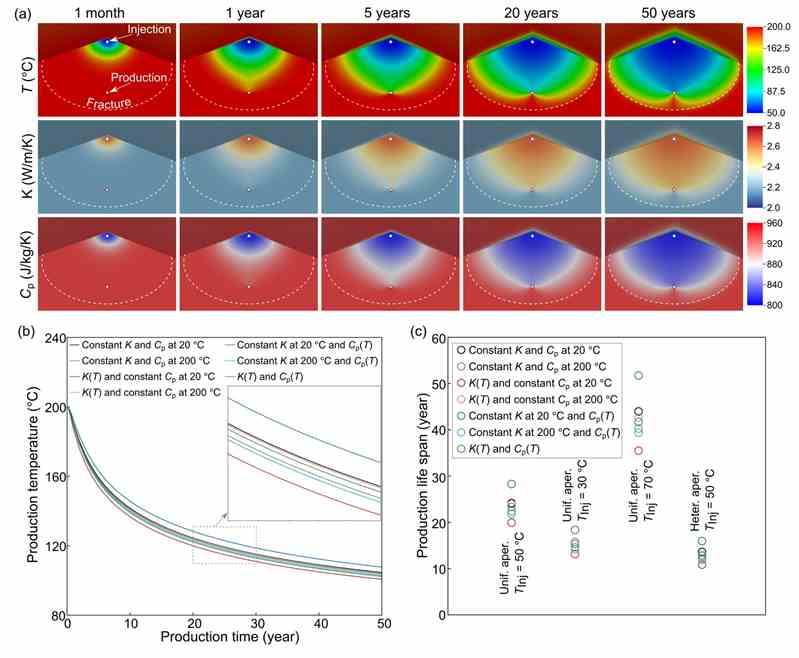The impact of thermal drawdown-induced alterations in rock thermal properties on heat recovery
Published 16 May, 2023
Geothermal energy, found in subsurface hot dry rocks, is a viable option instead of fossil fuels. Enhanced geothermal systems (EGS) enable us to use the plentiful amounts of energy in the hot rocks. The optimization and risk management of this process necessitate the accurate predictions of long-term thermal performance under different scenarios, which are usually done through numerical modelling.
Rock thermal parameters such as thermal conductivity and specific heat capacity must be accurately determined for reliable numerical model input. These parameters often experience variations because of the reduction of temperature when recovering heat—something which has been proven by multiple studies. Nonetheless, most existing numerical models tend to neglect these variations.
To that end, a team of researchers from Peking University investigated the effect of temperature-dependent rock thermal conductivity and specific heat capacity on the thermal performance of an EGS model.
“Previous experimental studies on different types of rocks indicate that when temperatures are reduced in an EGS, rock thermal properties change significantly,” shared Hui Wu, lead investigator of this study. “Our goal is to find out how these changes affect the long-term thermal performance of the EGS. We believe the results can be used to guide future numerical studies.”
The team demonstrated that on one hand, the increase of thermal conductivity caused by temperature reduction accelerates thermal conduction from rock formations to fracture fluid, which improves thermal performance. On the other hand, the decrease of specific heat capacity due to temperature reduction impairs the thermal performance, but the impact is smaller than that of the increase in thermal conductivity.
Their findings are published in the KeAi journal Rock Mechanics Bulletin.
“An interesting point to note is that, while thermal conductivity and specific heat capacity have contrasting impacts on EGS thermal performance, their combination effect is minimal,” said Wu. “Mainly, the thermal performance is determined by the product of rock thermal conductivity and specific heat capacity.”
“Apparently, keeping a constant rock thermal conductivity and specific heat capacity measured at room temperature can accurately forecast the EGS model's thermal performance” added Wu.

IMAGE: (A) VARIATION OF TEMPERATURE, THERMAL CONDUCTIVITY AND SPECIFIC HEAT CAPACITY DURING HEAT RECOVERY. (B) THERMAL BREAKTHROUGH CURVES UNDER DIFFERENT THERMAL PARAMETERS. (C) PRODUCTION LIFE SPANS UNDER DIFFERENT THERMAL PARAMETERS. RESULTS WITH DIFFERENT INJECTION TEMPERATURE ARE SHOWN. A HETERGENEOUS APERTURE SCENARIO IS ALSO SHOWN.
Contact author details: Hui Wu, Assistant Professor at School of Earth and Space Sciences, Peking University, Beijing, China, hui.wu@pku.edu.cn.
See the article: Wu,H., Liu,Y., Yang,M., Zhang,J., Zhang,B. (2023). Effect of temperature-dependent rock thermal conductivity and specific heat capacity on heat recovery in an enhanced geothermal system. Rock Mechanics Bulletin, 100045.